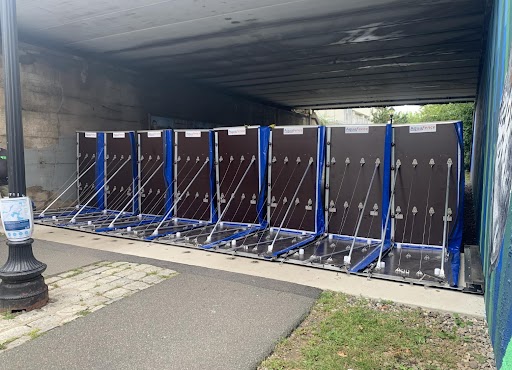BOSTON’S ROADWAYS and docks have only just dried after the latest King Tide, and facing a future of higher sea level rise and more flood events, the city is doubling down on a combination of permanent and short-term solutions to shore up its coastline. Some of those temporary options – known as deployable flood barriers – will be showcased in a novel city tour on Friday.
The city of Boston is encouraging people to stroll through its hopefully not-too-soggy streets on Friday for its first “deployables day.” Across the seaport and downtown areas, mobile flood walls will snap into place guarding major buildings, greenways, and T stations.
“Boston is among the most vulnerable cities in the country to flooding,” the event page notes. “As sea levels rise, damaging floods will shift from a rare occurrence to a common reality.”
The event is a way to get residents more familiar with the look and usage of deployables as the city heads into winter – its peak flooding season.
A City of Boston illustration of deployable flood barriers
“We always need to be planning for coastal adaptation across the city, and looking at it at a broad scale, but also on a site-by-site basis as well,” said Joe Christo, managing director of the climate resilience-focused Stone Living Lab. “I think that you really need to have a network of different approaches to address Boston’s 47 miles of coastline.”
Deployable flood barriers can mean many different things, but they are all temporary ways to block water.
Boston’s climate resilience design standards lay out a host of options – some that are pre-installed at the location and can be raised up when needed, mobile options like sand bags brought to and from a site, or systems that deploy and retract automatically if flooding reaches a certain level. Barriers can be rigid walls or soft and flexible. They can be tubes or containers filled with water, soil, or rock. Some connect to other permanent flood control systems or stand alone.
Most cities now lean away from single-use barriers like sandbags and toward reusable laminate or metal panels that can be brought to the site on short notice or raised from a hidden flat position at sidewalk-level when flooding is expected.
Folded up AquaFence barriers can be stored offsite and quickly installed when needed. (City of Boston photo)
The city’s strategies to address flood risk are “focused on different time horizons,” said Chris Osgood, the director of the Office of Climate Resilience. While Boston works on long-term mitigation-plus-open-space projects like Martin’s Park in the Seaport or McConnell Park in Dorchester, weather events and tides aren’t holding off to fit a government timeline. And capital projects take years, even decades to come to fruition.
“The future really is more about transforming the coastline,” Osgood said, “but because those projects will take time, there is an opportunity for us to think about some of these interim measures.”
Much of Boston’s resiliency efforts depend on private development. Several of the major buildings along the waterfront have used portable barriers for years. Atlantic Wharf Tower stores its temporary flood walls offsite until they’re needed, erecting unfolding linkable AquaFence barriers that can hold off water from rushing through.
The barriers may be temporary, but there still needs to be coordination with the city. If flood barriers are going to block rights-of-way, the property owners have to get approval from the public works divisions. Any building with deployable flood walls must be in communication with inspectional services and emergency services, plus meet certain review standards.
MBTA stations are major points of vulnerability to flooding as well. In 1996, flooding around the Fenway Portal entrance to the Green Line caused almost $70 million in damage and shut down major portions of the line for two months. While temporary measures have been in place since then, a massive 2019-2020 overhaul of its flood protection systems – including floodgates, large steel doors, and pumping systems – offered a more long-term fix and cost $22.2 million.
Sturdy, industrial looking metal panels can surround the Aquarium station entrances when waters rise.
The Climate Ready Boston plan meshes natural coastal solutions, permanent flood barriers, and networks of deployables at sites that are vulnerable during certain flooding events. It isn’t that the city wants every property to start throwing up personal seawalls, but deployables could be used in more locations if property owners and residents are aware of the option.
“I think that comprehensively planning for climate resilience and coastal resilience requires an all-hands-on-deck approach, and engaging residents in every step of that process is essential,” Christo said. Inherently, an awareness event around deployables is also an awareness event about the risks of climate change and flooding.
“The goal for any major city is to not have to utilize these deployables,” he said. “These are an interim solution, and as cities like Boston are implementing larger scale climate adaptation approaches, it will hopefully reduce the need for deployables at a site-by-site basis.”
The post With flood season approaching, it’s ‘deployables day’ in Boston appeared first on CommonWealth Beacon.

